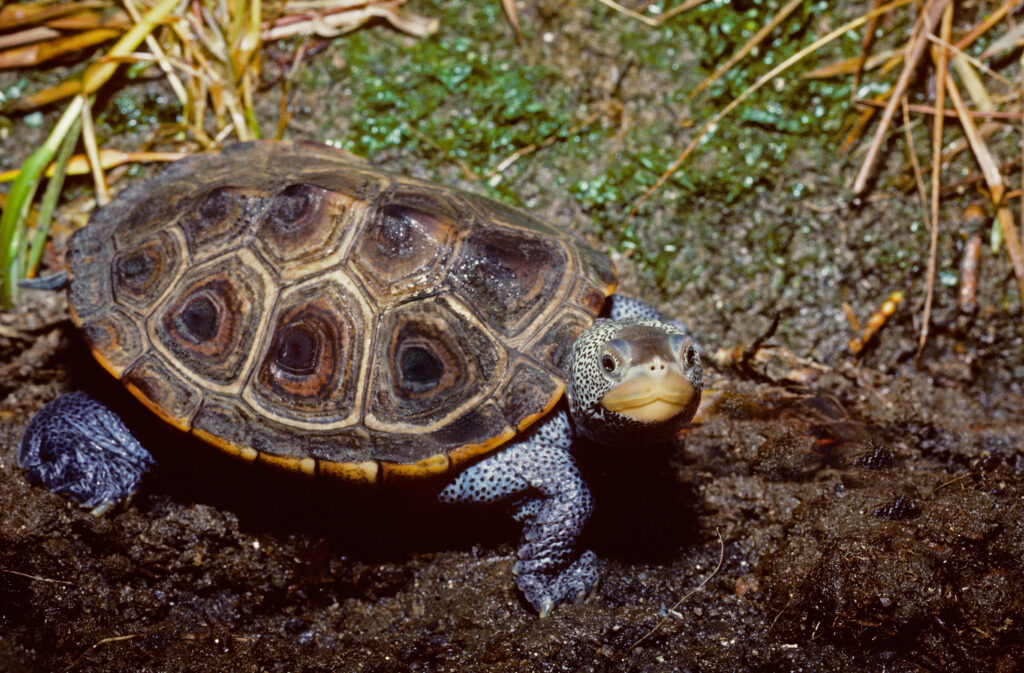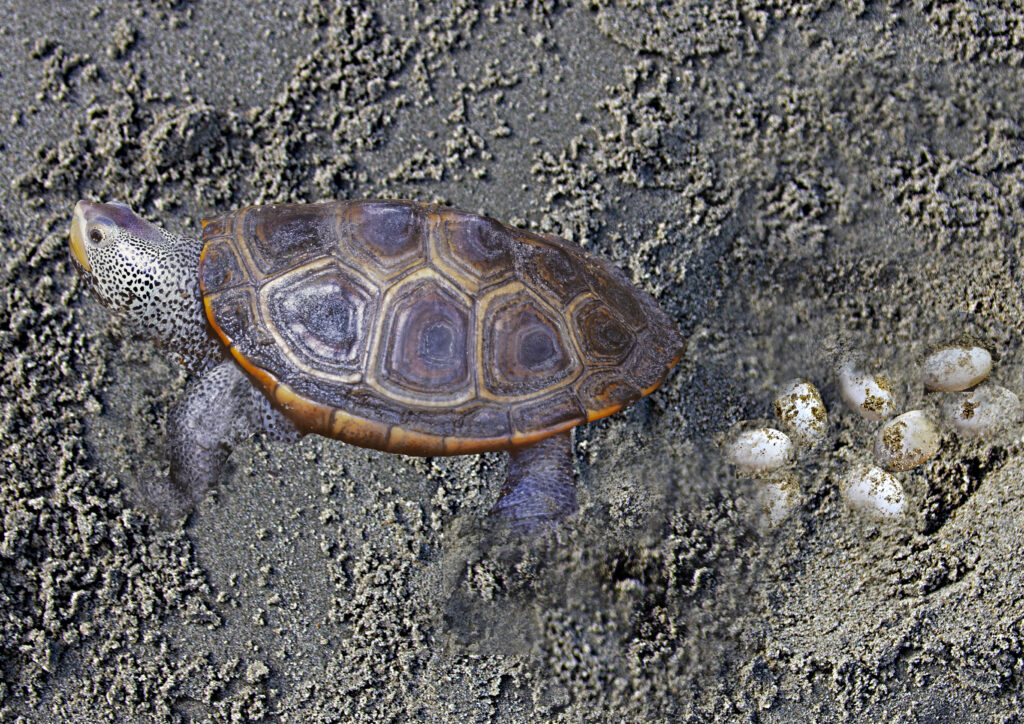Hidden in the shallows of coastal tidal salt marshes are very special gems, some of which are 5 to 9 inches in length. They are not glistening diamonds; they are turtles, whose shell is adorned with diamond-shaped plates (scutes) with different colored growth rings, giving them the name diamondback terrapin. Their shell color generally varies from green, gray, brown to almost black. Below their shell, their body varies in color from gray to yellow, green and white. The skin can also have different shaped black spots. A dark streak just above the upper lip of the lighter color terrapins sometimes resembles a “moustache.” Of the seven recognized subspecies of terrapins, ranging from Cape Cod to Texas, ornate diamondbacks are only found on Florida’s Gulf coast. In the center of each of their diamond shapes is an orange or yellow mark, adding to their attractiveness.

These fascinating creatures are the only North American turtle species that live their entire lives in an estuary, where river fresh water and ocean saltwater mix. Their thick scaled skin helps prevent salt from seeping into their body. When it rains, they can sometimes be spotted swimming with their head stretched out, just above the water’s surface. With their mouth wide opened, they manage to catch a drink of freshwater. They are also capable of obtaining some fresh water from a thin layer formed at the surface, before it mixes with the underlying saltwater. However, they do swallow small amounts of saltwater as they feed on their underwater prey. Special glands behind their eyes, help them regulate their body’s salinity.
Equipped with very strong beaks and thick jaw plates, their major prey items are snails like periwinkles, mud snails, coffee bean snails (Melampus), blue mussels and horse mussels, fiddler crabs, mud crabs, small blue crabs and some marine worms. When confronting a larger blue crab, the terrapin may simply bite off one of the crab’s claws, hopefully before one of its forelegs is caught up by the irate crab.
Terrapins are not related to sea turtles. However, their strong muscular legs and webbed hind feet easily propel them at the surface and underwater. They can remain underwater for long periods as they search for food and avoid predators.

Salt marshes are one of the most productive ecosystems on earth. They can be visited on foot wearing rubber boots or sneakers and long pants. Exploring a salt marsh aboard a canoe or kayak can also be a rewarding experience. Fiddler crabs scurry around the exposed mudflats while many different species of birds and various butterflies and other insects cling to tall waving salt-marsh cordgrass (Spartina). A ripple at the surface of nearby water may reveal a terrapin raising its head just enough to catch a breath of air. It remains there for less than ten seconds before returning toward the bottom of the creek. With luck however, a “diamond” may be resting on the marsh surface, exposing its attractive beauty. An explorer may even be fortunate enough to spot a female terrapin laying her egg. She digs a 4- to 8-inch-deep hole dug in wet sand or mud, located just above the high tide line. Incubation ranges between 9 to 15 weeks. The hatchlings emerge from their egg using a small egg tooth. Barely 1 to 1.25 inches in length, they generally remain near the edge of the marsh for the first few years of life. Some even remain in their nest during their first winter. With the onset of warmer weather, hatchlings seek out and remain in dense cover such as marsh grasses and tidal wrack.
In Connecticut waters, females have been observed laying eggs just once per year. In New York, females are known to produce two clutches during the nesting season. The more southernly subspecies of terrapins produce two or more clutches annually.
The sex of the new hatchlings is determined by the incubation temperature. Degrees between 77 to 81 produce nearly all males. Females hatch between 85 to 87 degrees. Those between 82 and 84 degrees generally result is a mix of male and female. During incubation, terrapin nests can be prey for raccoons, skunks and foxes. Once away from their nest, they become an easy catch for seagulls, crows and black-crowned night herons.
Males are smaller than females. Males grow to about a shell length of 5.5 inches: females can grow to 11 inches. Males reach sexual maturity at 2 to 3 years: females do so at 6 to 7 years. In the wild, diamondback terrapins can live 25 to 40 years.
As autumn water temperatures dip down to about 45 to 500F, adult terrapins make their way to deeper portions of the tidal creeks where they burrow into a muddy bottom. Some of the turtles choose to hibernate alone, while others are concentrated together is a relatively small area. During a winter thaw, some re-emerge for a short time only to return to hibernation as the temperature drops once again.
Exploring a salt marsh can be a great experience for any nature lover, photographer or artist. Diamondbacks are just one of many fascinating creatures and plants that can be discovered and admired while exploring a salt marsh!
